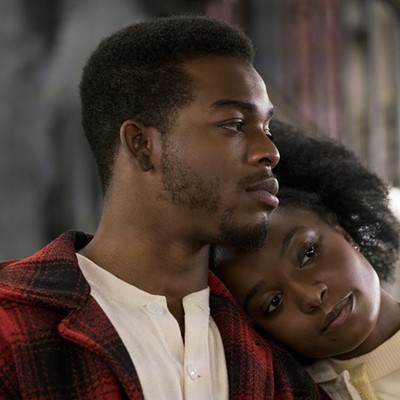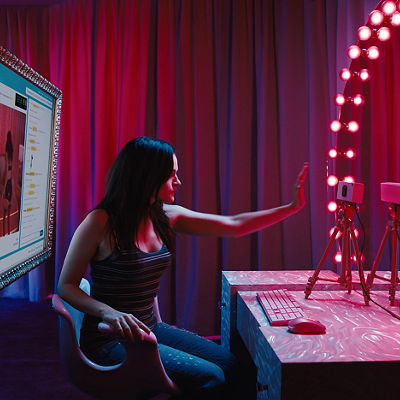Sofia Coppola had her 21st birthday party at the Chateau Marmont — a fact she had forgotten until Phil Pavel, the manager of the hotel, reminded her while she was there shooting her new film, Somewhere. It's the first feature to be granted clearance to shoot extensively inside the rooms and on the grounds of the infamous Sunset Boulevard hideaway, legendary for its starry scandal sheet. It's the site where John Belushi and Helmut Newton died, where sometime-Coppola-muse Scarlett Johansson allegedly had sex with Benicio Del Toro in an elevator (an event nodded to in Somewhere), from which Britney Spears was — allegedly! — banned for "smearing her dinner on her face." It is an official landmark, No. 151 on the city's list of Historic-Cultural Monuments. In contemporary pop culture, it's a symbol of Peak L.A. — a concentrated dose of a certain fantasy version of this city's secret life.
Back when Sofia first became a regular, in the early '90s, the Chateau had just been purchased by superstar hotelier Andre Balazs and was on its way back from a period of decline. Coppola was on the comeback trail, too: In 1990, at the age of 19, she disastrously co-starred as Mary Corleone in The Godfather, Part III, written and directed by her father, Francis Ford Coppola. Sofia, who had no formal acting training, was pinch-hitting for Winona Ryder, who dropped out at the last minute. Her performance was decimated by critics: Press screening audiences were said to have snickered loudly during the climactic scene that has Mary taking a bullet meant for her father and collapsing with the cry, "Dad?" The fact that the character has an incestuous relationship with her cousin added a layer of irony to complaints that the Coppolas were "keeping it in the family" against best advice and good taste.
In 2000, she'd face down the haters by writing and directing an adaptation of Jeffrey Eugenides's novel The Virgin Suicides. Her first feature, it's a visually stunning, 1970s-bikini poster-meets-homeroom notebook-doodle reverie nailing that ineffable adolescent blend of lust, obsession, depression and awkward connection. Four years later, at age 32, she'd win an Oscar for writing her second feature, Lost in Translation. But for a long stretch of her 20s, she was just lost.
_____________________
Sofia Coppola seemed to be everywhere in the mid-'90s, a kind of Paris Hilton with gallery cred, a daughter of privilege drifting between quasi-creative opportunities afforded by her wealth, beauty and birth-given spotlight. With her long caramel hair and red pout, waify body in hip-hugger skirts and kitschy baby-tees (which she designed and marketed herself, through the fashion line Milk Fed), she was a poster girl for '90s cool. She did nothing, and everything. She studied photography while modeling for alt-fashion and teen magazines. She vamped in music videos for the Black Crowes, Madonna and Sonic Youth, sometimes alongside best friend Zoe Cassavetes (daughter of John). She appeared tastefully topless in a Vanity Fair spread on "it" girls, almost mocking the endeavor by saying: "I don't want to be part of some Brat Pack thing." She later admitted to People magazine, "There was a year I did nothing but go out. I was pretty flaky."
"I was really frustrated that I wasn't really great at one thing, but that I had a lot of interests in different areas," Sofia says today, over lunch in the lobby of the Chateau on an unseasonably sunny November day. Now 39, she looks much younger. Extremely petite, she wears her hair in a pointedly unpolished bob. In an oversized sweatshirt, jeans paired with an expensive-looking tennis bracelet that seems to be falling off her tiny wrist, and a giant ring that she keeps accidentally banging against the table when she gesticulates, she almost vibes as a little girl playing dress-up, even as she small-talks the minutiae of motherhood. (Jet-lagged four-year-old daughter Romy, she says, "woke up at, like, four in the morning raring to go.")
It was reading Eugenides's book that changed everything, giving Sofia the push she needed to focus those different interests into filmmaking. "There are people who want to be a director and then think about what they wanna do," she muses. "Or, it comes from something that you want to express."
It's a great Hollywood turnaround story. It's more impressive when you consider where she went from there.
_____________________
Drawing on both her wistful memories of coming of age as the daughter of celebrity and the tsuris of her twenties, Somewhere is a defiantly austere film, the most challenging Coppola has made to date. The first image is a three-minute-long, static shot of a black Ferrari circling a strip of track in the dead of the desert. The driver, we come to find out, is a depressed, withdrawn movie star named Johnny Marco (Stephen Dorff). Cue opening credits, which play to a version of "Love Like a Sunset," by Phoenix, the French band fronted by Thomas Mars, the father of Sofia Coppola's two young daughters. The song, which helped inspire Coppola's script, is fueled by an electronic buzz that's almost identical to the sound of Johnny's Italian sports car's engine. Patches of the track serve as a refrain throughout the film, which, in virtual vérité style, tracks a couple of weeks that Johnny spends living at the Chateau while doing press for one shitty blockbuster and prepping for another; nursing a broken arm and binging on painkillers; and quietly, unexpectedly reaching some sort of breakthrough with his preteen daughter, Cleo (Elle Fanning), who spends a few days with him and temporarily turns his hotel room into a home.





